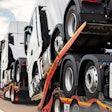
Agriculture often gets a bad rap when it comes to greenhouse gas (GHG) emissions. But Marty Matlock says U.S. ag producers have the potential to become net GHG negative.
Matlock, who is a professor in the Department of Biological and Agricultural Engineering at the University of Arkansas – Fayetteville, said if U.S. producers implemented existing practices more comprehensively, they would increase soil resilience and reduce risks from climate change impacts. And, if global agricultural producers adopted the current practices common in the U.S., they could potentially cut agricultural emissions in half.
“Agriculture is a major solution for climate change emissions and impacts,” he said. “Agriculture as a sector, and agricultural producers in particular, are part of the solution to the global greenhouse gas emissions imbalance. Agricultural producers in the U.S. have reduced total emissions by 20% in the past two decades, so agriculture is only 10% of total U.S. emissions.”
Transportation, electric power and industry each contribute roughly 25% of GHG, and the remainder comes from residential and commercial activities.
“The most common misperception is that animal agriculture is responsible for a large portion of global greenhouse gas emissions annually. This is not correct,” Matlock said.
Reducing GHG emissions in animal production and management
Matlock is a co-author of the publication, “Potential for U.S. Agriculture to be Greenhouse Gas Negative,” which outlines how combining reduced GHG emissions from some agricultural activities with increased carbon sequestration in others could achieve GHG-negative agriculture.
One opportunity for the industry outlined in the paper was in animal production and management.
“A wide range of opportunities exist within animal production systems to reduce emissions and are contingent on the type of production system,” the paper said. “There are three areas of potential impact: feeding systems for ruminants, manure handling and feed production.”
But how should producers choose what practices to implement?
“The practices that pay are the practices that stay,” Matlock said. “Producers should focus on animal production practices that make economic sense.”
Because feed is a major source of the total GHG emissions from animal agriculture, after manure emissions and enteric methane releases, feed use efficiency is a major metric for reducing GHG emissions, Matlock said.
Improving feed intake efficiency — by avoiding feed waste ("don’t feed the barn floor"), balancing nutrients for optimal absorption, and aligning feed composition with the animal’s growth and production stage — can increase output (meat, milk, eggs, etc.) per unit of feed while also reducing enteric methane and manure production.
“Providing good animal health and welfare is also a key management practice for reducing GHG emissions,” he said. “Stressed or unhealthy animals are less efficient at feed conversion. These are principles that animal producers have understood long before GHG emissions became a concern.”
Energy efficiency can lower GHG emissions
Energy use in agricultural systems is often overlooked as a potential area to lower GHG emissions, the paper said.
“Overall energy GHG emissions on the farm can be reduced by transitioning to renewable energy, especially electrical power sources to replace internal combustion engines,” Matlock said, adding that feed mills have two categories of emissions: facility emissions on an annual basis, and efficiency emissions based on each mass of feed produced.
When measured by facility on an annual basis, many feed mills have secured power purchase agreements with solar power providers to lock in lower utility rates while supporting renewable energy in the portfolio from their regional power pools. Feed milling efficiency can be increased by reducing loss through the system, increasing energy recovery in boiler systems, and use of variable speed controls for electric motors to provide targeted power where and when it is needed.
“All of these practices save money over time as well as reduce GHG emissions,” he said.
Soil carbon sequestration can be costly
However, “not every practice that is necessary to create GHG-negative agriculture makes more profit for the producer,” Matlock said.
The most critical practice in tipping the carbon balance to negative is soil carbon sequestration, he said. The practices that increase total soil carbon can be costly on an annual basis for row crop producers, depending on the history of the field, soil type and condition, climate, and cropping strategies. While increasing total soil carbon makes the soil more resilient to stresses and increases overall producer resiliency, these benefits can take decades to realize.
“Farmer viability is often measured in production seasons,” Matlock said. “Many farmers rent their lands, with no certainty of recovering these investments, further complicating the economic benefits of increasing total soil carbon.”
This is why practices that increase total soil carbon should result in direct and immediate benefits to producers, he said. These practices have demonstrated benefits to crop resilience, so they should result in reduced crop insurance rates, for example. Producers who implement these practices are more likely to withstand weather-related disruptions and therefore should receive lower interest rates on loans. Finally, conservation incentive programs should be targeted to support these practices with cost-share and direct payment programs.
“Many of these programs are already in place, but they need to be amplified to achieve the vision of GHG-negative agriculture,” Matlock said.
Practices, technologies needed to achieve GHG-negative ag
The biggest roadblock to achieving GHG-negative agriculture, Matlock said, is the cost of implementation, followed by lagging innovations in crop genetics, electric traction systems, field-scale sensors and controls, and integrated farm data management and risk decision software.
“Successful and resilient animal agriculture producers, generally defined as those still in business, are innovators and adopters of practices that ‘make dollars and sense,’” he said.
The potential of emerging technologies, such as artificial intelligence, machine learning and system-level computer simulation models, will continue to advance the evaluation of current and future scenarios across a wide range of settings, the paper said.
Practices that add value and provide understanding will provide agricultural producers toward adoption.
For example, feed is the largest input cost for animal producers, so reducing feed costs per production unit increases profits, and generally reduces GHG emissions. Innovations in lighting for controlled animal production systems have decreased electrical costs and increased quality of life for the livestock.
“If it pays, it stays,” Matlock said.










